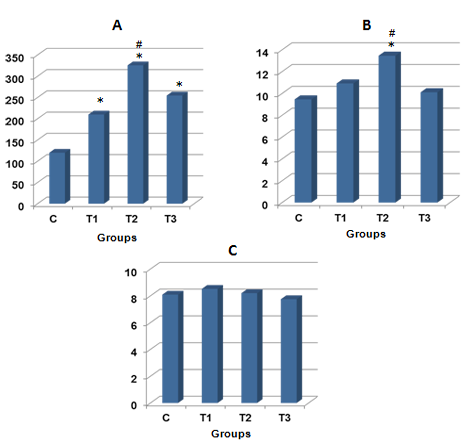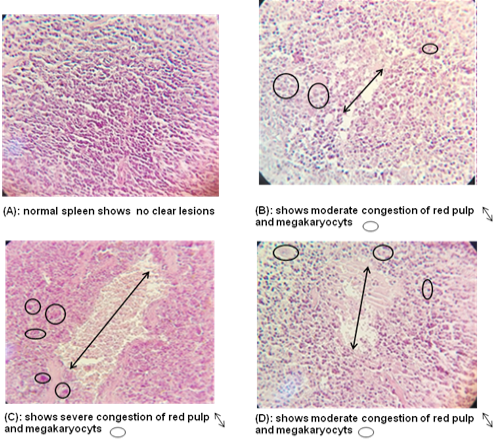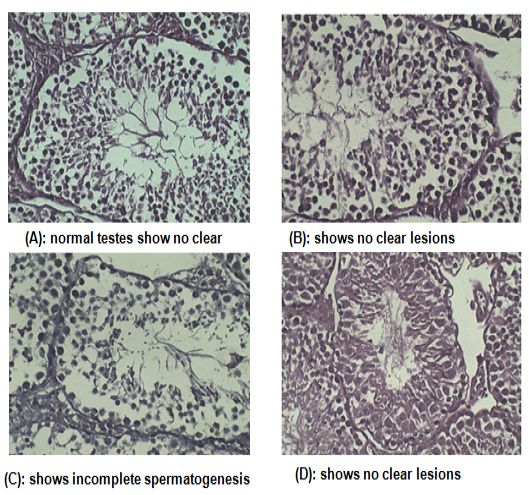Advances in Animal and Veterinary Sciences
Research Article
Incomplete Spermatogenesis, Leukocytosis and Thrombocytosis Appeared with Energy Drink Consumption in Mice at Differences Consuming Periods and Concentrations
Jamela Jouda, Ali Jawad Al-Sudani, Samal Hakeem Kareem Al-Jaff*
Mustansiriyah University, College of Science, Biology Department, Baghdad, Iraq.
Abstract | To study the effect of energy drink on blood cells counts and histopathological changes on spleen and testis in mice according to consuming period and concentration. Sixteen male Balb/c mice, six weeks old, were used in this study, divided into 4 groups (4n in each group); (T1) group consumed energy drink (28µl/ml water) during 10 days, (T2) group consumed energy drink (28µl/ml water) during 20 days, (T3) group consumed energy drink (14µl/ml water) for 20 days, and (T4) group consumed only water and served as control. Blood were collected for counting white blood cells, platelets and red blood cells. Spleen and testis were collected for histopathological study. There were no differences among the change rate of body weight in all groups. Spleen weight was significantly higher while testis weight was significantly lower in all treated group comparing with control. There was no difference in RBCs count. Thrombocytosis significantly appeared in the mice consumed energy drink groups while leukocytosis significantly appeared only in (T2) group. The spleen of mice consumed energy drink groups were congestion in the red pulp and increase number of splenic megakaryocytes, while there was incomplete spermatogenesis in testes. These pathological and hematological changes were much severe in the (T2) group. In conclusion, Chronic consumption of energy drink in mice affect negatively on spermatogenesis. It caused also Thrombocytosis, leukocytosis, and a congestion in spleen red pulp.
Keywords | Testis, Thrombocytosis, RBC, Leukocytosis, Spleen, Energy drink.
Received | November 04, 2018; Accepted | January 19, 2019; Published | March 02, 2019
*Correspondence | Samal Hakeem Kareem AL-Jaff, Mustansiriyah University, College of Science, Biology Department, Baghdad, Iraq; Email: samalhk@uomustansiriyah.edu.iq
Citation | Jouda J, Al-Sudani AJ, AL-Jaff SHK (2019). Incomplete spermatogenesis, leukocytosis and thrombocytosis appeared with energy drink consumption in mice at differences consuming periods and concentrations. Adv. Anim. Vet. Sci. 7(5): 356-360.
DOI | http://dx.doi.org/10.17582/journal.aavs/2019/7.5.356.360
ISSN (Online) | 2307-8316; ISSN (Print) | 2309-3331
Copyright © 2019 Jouda et al. This is an open access article distributed under the Creative Commons Attribution License, which permits unrestricted use, distribution, and reproduction in any medium, provided the original work is properly cited.
Introduction
Energy drinks (EDs), non-alcoholic water-based flavored beverage, is a term which has been used to include a beverages category have appeared recently in markets of different countries worldwide such as in Africa, European and North American. These markets have also grown quickly in the Arab word (Galemore, 2001).
EDs contain catalyst substances such as Caffeine, Guarana, Taurine, Ginseng or other plant extracts, incorporation with other substances such as carbohydrates, vitamins, and mineral (Taiwo and Aesokan, 2018). The specific purpose to market these drinks is to provide enhanced physiological and/or performance effects, real or perceived (Ishak et al., 2018). Majority of society segments which consume -large doses of these energy drink are athletes, teenagers and college students who hope to increase their energy level or compensate lack of sleep (Khayyat et al., 2014).
Excessive consumption of Caffeine, the main active ingredient in energy drinks, by children and adolescents may result to Caffeine intoxication which causes to vomiting, seizures, tachycardia, cardiac arrhythmias, and death (Olaleru and Odeigah, 2015). Although, Santhakumar reported that if the concentrations of taurine and Caffeine are low in energy drinks, they may play a role in prevention of risk factors leading to cardiovascular disorders. But this suggestion need to studied (Santhakumar et al., 2012). Several warnings have been issued from studies regarding possible adverse effects of energy drinks including liver and renal toxicity (Munteanu et al., 2014; Khayyat et al., 2012). Olaleru and Odeigah, (2015) reported that these drinks caused significant reduction in normal sperm counts. Park found that the reduction in size and growth of testis caused by Caffeine, he also found altered testis histomorphology after Caffeine consuming (Park et al., 2015).
Khayyat et al. (2014) showed that the overdose of Caffeine and other bioactive ingredients in energy drink decrease erythrocytes and WBC counts, HB and PVC value due to its effect in action of hematopoietic system. These effects need more work to prove it. So this research aims to study the effect of energy drink on blood cells counts and histological changes in spleen and testis to evaluate the effect of this energy drink on hematology and testicular systems according to consuming period and concentration.
MATERIALS AND METHODS
This study complies with ARRIVE Guidelines and carried out in accordance with the U.K. Animals (Scientific Procedures) Act, 1986 and associated guide lines, EU Directive 2010/63/EU for Animal Experiments.
Subjects
Sixteen Balb/c mice male, six-week old, were used in this study. Eight mice consumed energy drink at concentration 28µl energy drink/ml water (high concentrate), four of them were killed after 10 days, (T1) group and the other four were killed after 20 days (T2) group. Third mice group (T3) consumed the energy drink at final concentration 14µl/ml water (low concentrate) for 20 days (n=4). The last four mice consumed only water and served as control. Mice all groups drank around 3ml/day.
Methods
The mice were killed by cervical distraction at different times after energy drink consumption. Blood was collected from eyes in sterile tube. Spleen and testis were collected and put in 10% formalin solution, processed by standard procedures sections of paraffin-embedded tissue were stained with hematoxylin and eosin then examined by light microscopy. Blood samples were used to make blood smear onto slide fixed and stained using Giemsa Stain to WBC, PLT and RBC counted by light microscopy.
Statistical Analysis
Results are expressed as mean ± standard Error (M±SE). Data were analyzed by one-way analysis of variance (ANOVA) followed by Fisher’s test for multiple comparisons, using Stat view version 5.0. Differences were considered significant when p<0.05.
RESULTS
The body weight of mice was measured in the zero time and before sacrificed them. Then the change rate of body weight was calculated. Table 1 shows the body weight of control, mice consumed high concentration of energy drink 28µl/ml water (T high), and mice consumed low concentration of energy drink 14µl/ml water (T low). It shows also the change rate of body weight. There were no differences among the change rate of body weight of these groups.
Table 1: the change rate of body weight of control and mice consumed energy drink
| Groups | Body weight(gr) in zero time (M±SD) | Body weight(gr) after 20 days (M±SD) | Change rate of body weight(gr) |
| Control | 24±1.9 | 25.5±1.1 |
1.06 |
|
T high* |
25.1±2.9 | 27±3.3 |
1.07 |
|
T low* |
26.5±2.3 | 28±2.1 |
1.06 |
*T high: Mice consumed energy drink 28µl/ml water. *T low: Mice consumed energy drink 14µl/ml water.
The weight of organs weights was also measured before put them in the paraffin solution, then the organs/body weight index of control and T1, T2, and T3 were calculated. The results were showed in the Table 2. Spleen weight was significantly higher while testes weight was significantly lower in the mice consumed energy drink groups compared to control. These changes of the organs weights were significantly higher in the mice consumed energy drink for 20 days (T2 and T3). Spleen/body weight index was significant while testis/body weight index was significantly lower in the mice consumed energy drink groups compared to control. These changes of the organs/body weight index were significantly higher in the mice consumed concentrated energy drink for 20 days (T2).
Table 2: the change of spleen and testis/body weight index of control and mice consumed energy drink
| Groups | Body weight (M±SD) | Spleen weight (M±SD) | Testis weight (M±SD) | Spleen/body index | Testis/body index |
|
Control |
25.5± 1.089 |
0.14± 0.045 |
0.073± 0.004 |
0.0054 |
0.0028 |
|
T1 |
26.3± 2.56 |
0.26± 0.076* |
0.062± 0.008* |
0.0097* |
0.00 24* |
|
T2 |
27± 3.32 |
0.38± 0.079*# |
0.056± 0.011*# |
0. 0142*# |
0.00 20*# |
|
T3 |
28± 2.12 |
0.32± 0.031*# |
0.059± 0.0004*# |
0.0114* |
0.00 22* |
*Significant differences between control and consumed energy drink groups,
#Significant differences among consumed energy drink groups.
While there was no difference in the red blood cells count among control group (8.09±0.30) and mice groups consumed energy drink (T1=8.52±0.48,T2=8.20±0.31,T3=7.75±0.20), PLT numbers were significantly higher (Thrombocytosis) in the mice groups consumed energy drink (210±12.7, 326±11.3, and 255±11.1, respectively) compared to control (120±8.12). The highest number of PLT was in the mice group consumed high concentration of energy drink for long time (T2). Similar result, WBC numbers were also higher in the mice groups consumed energy drink (Leukocytosis) (T1=10.92±1.48 and T3=10.11±1.00) but it reached the significant limit only in the T2 group (13.46±2.59) compared to control group (9.46±0.68). (Figure 1).

Figure 1: platelets (PLT)PLT×109 cell/ml2(A), while blood cells (WBC) WBC×109cell/ml2(B), and red blood cells (RBC) RBC×1012 cell/ml2(C),counts in the control (C) and mice consumed energy drink groups; high concentration for 10 days (T1), for 20 days (T2), and low concentration for 20 days (T3). *Significant differences in control vs. consumed energy drink groups, #Significant differences among consumed energy drink groups.
The histopathological changes in the spleen of mice consumed energy drink groups were congestion in the red pulp, moderate in the mice consumed high concentration energy drink for 10 days (T1) and consumed low concentration energy drink for 20 days (T3) but sever in the mice consumed high concentration energy drink for 20 days (T2) (Figure 2).
In testis sections there were no clear lesion in the control, in the mice consumed concentrated energy drink for 10 days, and the mice consumed low concentration energy drink for 20 days while the section of the mice consumed high concentration energy drink for 20 days shows incomplete spermatogenesis (Figure 3).

Figure 2: Histopathological sections in spleen of control (A), mice consumed high concentration energy drink for 10 days (B), for 20 days (C), and consumed low concentration energy drink for 20 days (D)

Figure 3: Histopathological sections in testis of control (A), mice consumed high concentration energy drink for 10 days (B), for 20 days (C), and consumed low concentration energy drink for 20 days (D)
DISCUSSION
During the 10 or 20 days of consuming energy drink in high and low concentrations, there were no change in the weight of body but there were differences between the weights of organs. The weight of organs and the index of organs/body weight in the group of mice consumed energy drink were higher than control and the highest was in the T2 group. These results suggested toxicity effect of energy drink on the testis and spleen organs which matched with the histopathology results of these organs.
Several compounds of energy drink may be associated with these toxicity signs of energy drink such as Caffeine, Guarana, and Taurine (Schuchowsky et al., 2017).
Many works of literatures studied the effect of these individual components of energy drinks, most of which are at an initial stage, with the exception of Caffeine, which almost completely studied and explained the mechanism of work and how it works on the body. The effects of Guarana are still poorly understood, although it is well known that products containing large amounts of Guarana have physiological effects similar to those found in Caffeine. There is the same scarcity of studies for taurine and other components contained in energy drinks (Kantamala et al.,1990), as well as for the cumulative effects of these substances with each other.
One of the toxicities of energy drink found in this study is its effected on the blood cells, especially white blood cells and platelets which were higher in the mice group consuming energy drink.
Some pieces of literatures found decreased of white blood cells by Caffeine treatment and explained it by its effect on action of hematopoietic system (Khayyat et al., 2014) or on the level of intracellular Ca+2 which may occur in side white blood cells (Katz et al., 1977), just like in skeletal and muscle cells (Blinks et al.,1972; Worthley et al., 2010), but some other literatures, which studied the long term of high dose treatment of Caffeine, found hyperactivity of white blood cells (Katz et al., 1977). We did not found research studied taurine, Guarana, or energy drink effect on white blood cells.
Several studies have been conducted to confirm the harmful effects of these energy drinks on heart health. Worthley et al. (2010) reported that consumption of energy drink significantly increases platelets buildup and reduces function of endothelial in young adults (Lev et al., 2007). Interestingly, other studies have shown inhibition effect of some energy drink compounds individually on aggregation of platelets such as Caffeine due to an increase in the cyclic adenosine mono-phosphate (cAMP) (Schuchowsky et al., 2017), and taurine by all agonists used (Santhakumar et al., 2012). Alteration of platelet correlates with elevated blood glucose concentration (Breddin et al.,1985) and spleen size (Van Der Meer et al., 2016).
The increased destruction of platelets when it elevated through increases the shear stress resulting in increased platelet aggregation rate, immune destruction, increased fibrin breakdown, bacterial proliferation, infection, and spleen size (Mitchell et al., 2016). In our study results not only the size of spleen elevated but there was also histopathological changes such as congestion of red pulp, which can be resulting from these destruction of platelets (Lv et al., 2018) and increase number of megakaryocytes, which show the significant difference between the sexes (Matsumura et al.,1984). The number of megakaryocytes in spleen may increase because of testis removal, elevated in estrogen levels (Matsumura et al.,1984), and neither testosterone nor progesterone. Since the elevated in number of splenic megakaryocytes caused by gonadectomy, the testis appears to exert a depressive effect on megakaryocytes in spleen (Matsumura et al.,1984). In our results the size of testis reduced and the spermatogenesis was incomplete caused by energy drink consuming which may cause elevated in the number of splenic megakaryocytes.
The incomplete spermatogenesis in our results may cause by gonadotoxic and pro-oxidant properties of energy drink. This result matched with Schukowsky et al. (2017) results which showed a reduction in sperm concentration by energy drink treatment. Caffeine has preferential targets on spermatogonia and Sertoli cells. It also causes little damage to the sperm, differentiate and produce mature spermatozoa (Dais et al., 2015; Shetty and Meistrich., 2005). Thus, the concentration of sperm would be reduced by the effect of Caffeine high concentration neither directly or indirectly, through the endocrine system (Shetty and Meistrich, 2005). In this study the incomplete spermatogenesis occurs in the mice group consumed concentrated energy drink for long time by damage in a spermatogonia cells, which may be proved the gonadotoxic effect of energy drink if consumed in high concentration and for a long time.
CONCLUSIONS
Energy drink seems to have toxic effect on testis, which can effect reproductive system activity, and blood cell count and hematopoietic organs. These effects were greater in the mice group consumed energy drink in high concentration and for long time.
CONflict of interest
The author has nothing to disclose and has no competing exist.
ACKNOWLEDGMENTS
The author would like to thank the histology Laboratory for preparing the histological section for histopathological examination.
authors contribution
Dr. Jamela Jouda has planned, designed, completed the statistical analysis and wrote the manuscript. Ali Jawad and Samal Hakeem has carried out the experiment work and the Laboratory tests. All the work of this article was under the supervision of Dr. Jamela Jouda, and all the others read and approved the final manuscript.
REFERENCES





